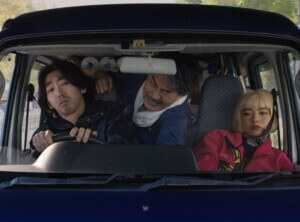Highrise buildings are the most commonly built form of the last century. So says A Short History of the Highrise, an interactive documentary that is a co-production of the National Film Board of Canada (NFB) and the New York Times Op-Docs which has its premiere at the 2013 New York Film Festival and will launch on the website on October 5. It explores the 2,500-year global history of vertical living in four short films: Mud, Concrete, and Glass, which draws on the Times photo archives. The fourth, Home, is comprised of images submitted by the public. The films can be stopped at any time by swiping, pinching, pulling and tapping to dig deeper into the stories, see the backs of photos, and play games. Questions like who gets to live on the top floor and why (in Roman times, upper floors were the least desirable) are asked in rhyme: “Were these vertical experiments there for elites? Or to warehouse the poor away from the streets?” We climb the Tower of Babel, the Hakka round houses of Fujian province, and medieval Yemenese Manhattan-like mud towers before arriving at New York’s luxury-serviced Osborne, London Terrace, and Dakota built simultaneously to the multi-story tenements of the Lower East Side. All are shown in still images cleverly animated: buildings grow up, skaters glide, women wink, lights turn on, and the text is read by well-known Canadian musicians Feist and Cold Specks, as well as the series director, writer and editor Katerina Cizek. The result is a delightful, visually stunning exploration that is seemingly simple, but actually stretches both the conventional documentary form and how we depict space.
This endeavor is the latest of a multi-year multi-format project of the NFB called Highrise. They have harnessed the tools of the digital revolution and fused them with tools of the social sciences, architecture, and design. Cizek has been working with the Massachusetts Institute of Technology’s OpenDocLab as an MIT Visiting Artist, and with York University’s CITY Institute.
The results thus far have been a series of web documentaries that tell tales “story by storey.” World of Highrises goes from the macro to the micro–Google Streetview aerials of countries, zooming into cities, and then specific highrises accompanied by a Wikipedia entry. We are encouraged to add to the roster. Living Proof shows that downtrodden highrise renewal is not a pipe dream. Examples of successful revitalization projects around the world are shown, narrated by architect Graeme Stewart who argues that it’s not the buildings themselves that are the problem so much as the system around the building. Cited are Hansaviertel in Berlin where a ground floor apartment was transformed into a cafe with terrace, and the facade brightened with an awning and paint.
The first documentary produced, Out My Window: The Towers in the World, the World in the Towers is comprised of interactive “Views from the Global Highrise.” Called a 360-degree documentary, it uses Yellowbird multi-lens panoramic video technology to look at the “concrete-slab residential highrise buildings that are the most commonly built form of the last century. On the outside, they all look the same. But inside these towers of concrete and glass, people create community, art and meaning.” More than 90 minutes of material features 49 stories from 13 cities, “not the Parises, Londons, Tokyos” but the mid-sized cities — Chicago, Toronto, Montreal, Sao Paolo, Havana, Amsterdam, Prague, Istanbul, Beirut, Bangalore, Phnom Penh, Tainan, Johannesburg — in 13 languages told in fragmented, non-linear fashion from the destruction of Cabrini Green in Chicago to the fallout of the Velvet Revolution in Prague, all from from very personal points of view. “One Highrise, every window a different city.”
One Millionth Tower is an interactive open-source documentary which reimagines what rundown highrises can be. Many of these concrete blocks are falling apart, and considered failures. Some are torn down, some renovated, but most left to decay. In Toronto there are 2,000 such high-rise towers. In this video, a cluster of suburban Toronto towers (19 towers with 19,000 inhabitants) are matched with architects and animators. Together they envision a market, a garden, a playground in dis- or un-used spaces. On this video journey, we travel through a virtual space online in a 3D experience using HTML5, flying over a gridded ground, rather than viewing a straightforward 2D film. Utilizing Popcorn, created by the open-source web browser Firefox’s parent, Mozilla, allowed the team to add interactivity to video by linking it with social media, news feeds, and data visualizations.
What you see is a series of stills accompanied by recorded conversations that are overlaid with what is re-imagined in drawings and animation. We come to understand the grim reality of the place, and the possibilities of changing that space with simple interventions–an abandoned tennis court becomes a performance arena with shallow stairs, a ravine becomes a stepped garden, a parking lot becomes a farmer’s market. Animators overlaid trees, a basketball court, bright colors, dancers, skaters, and a meditative garden. They tried to “make a photo come alive, to say `this space is alive.’ …. to slowly build the characters … breathing and moving” transitioning from daytime to nighttime. In fact, one of these dreams actually came to pass: the Toronto residents built their own new playground. After all the brainstorming for the documetary, they applied for a grant (it took 10 days to complete the proposal) which was awarded. 90 residents together with outside help, performed the labor. In a shot from One Millionth Tower, a resident blows animated “seeds” from her hand which float across the “garden,” alight, and take root, a harbinger of the new growth that followed.










